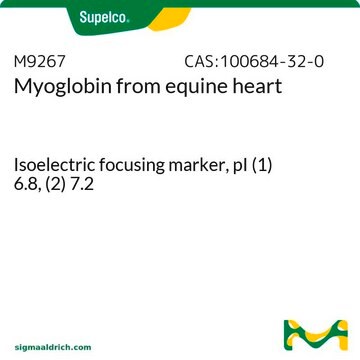This product is predominantly (>95%) in the oxidized form.
C2867
Cytochrome c from equine heart
BioUltra, ≥99% (SDS-PAGE), powder, suitable for mammalian cell culture
Synonyme(s) :
Cytochrome c from horse heart
About This Item
Produits recommandés
Source biologique
horse heart
Gamme de produits
BioUltra
Essai
≥99% (SDS-PAGE)
Forme
powder
Poids mol.
12,384
Conditions de stockage
(Tightly closed Dry)
Technique(s)
cell culture | mammalian: suitable
Solubilité
water: 10 mg/mL, dark red-brown
Numéro d'accès UniProt
Température de stockage
−20°C
Informations sur le gène
horse ... CYCS(100053958)
Vous recherchez des produits similaires ? Visite Guide de comparaison des produits
Catégories apparentées
Description générale
Application
Actions biochimiques/physiologiques
Notes préparatoires
Autres remarques
Code de la classe de stockage
11 - Combustible Solids
Classe de danger pour l'eau (WGK)
WGK 3
Point d'éclair (°F)
Not applicable
Point d'éclair (°C)
Not applicable
Équipement de protection individuelle
Eyeshields, Gloves, type N95 (US)
Faites votre choix parmi les versions les plus récentes :
Certificats d'analyse (COA)
Vous ne trouvez pas la bonne version ?
Si vous avez besoin d'une version particulière, vous pouvez rechercher un certificat spécifique par le numéro de lot.
Déjà en possession de ce produit ?
Retrouvez la documentation relative aux produits que vous avez récemment achetés dans la Bibliothèque de documents.
Les clients ont également consulté
Chromatograms
application for HPLCapplication for HPLCapplication for HPLC-
Is Product C2867, Cytochrome c, predominantly in the oxidized form or the reduced form?
1 réponse-
Utile ?
-
-
How do I determine how much of Product C2867, Cytochrome c, is in the oxidized form, and how much is reduced?
1 réponse-
This is determined by a spectral assay. The detailed assay procedure (operating procedure #11252) may be requested from Sigma St. Louis Technical Service ([email protected]).
Utile ?
-
-
How should I store solutions of Product C2867, Cytochrome c?
1 réponse-
Our general recommendations are as follows: Store at -20 °C (freezer) for up to six months. Store at 2-8 °C (refrigerator) for up to two weeks. Store at 20-25 °C (room temperature) for up to three days. According to J. Biol. Chem, 237, 2161-2174 (1962), cytochrome c is stable to boiling, and over an unusually wide range of pH values. However, it denatures readily at extreme pH (low or high), and in high concentrations of organic solvents, such as ethanol or acetone.
Utile ?
-
-
What is the Department of Transportation shipping information for this product?
1 réponse-
Transportation information can be found in Section 14 of the product's (M)SDS.To access the shipping information for this material, use the link on the product detail page for the product.
Utile ?
-
-
I see that you list several horse heart cytochrome c products. What are the differences, and which one should I choose?
1 réponse-
Product No. C2506 is prepared with trichloroacetic acid (TCA), whereas C7752 is prepared with the milder acetic acid. The TCA method may reduce the amount of superoxide dismutase (SOD) present, but tends to cause dimerization or acid-modified structures of cytochrome c. In contrast, acetic acid preparations may have slightly higher amounts of SOD, but a lower proportion of dimeric cytochrome c. So C2506 would be recommended for enzyme activity studies that require low SOD, whereas C7752 is recommended for structural studies or binding studies, or for enzyme activity studies where possible SOD contamination is not a problem. Product No. C2867 is prepared from C2506; it is a BioUtra grade product, greater than or equal to 99% pure as determined by SDS-PAGE. It is recommended when an ultra-high purity is required. Product No. C3256 is also prepared from C7752; it is isolated by ion-exchange chromatography. This fraction shows a high rate of ascorbic acid oxidation, but low activity in a cytochrome oxidase system. Product No. C7150 is also prepared from C7752; it is suitable for use as a gel filtration molecular weight marker.
Utile ?
-
Filtres actifs
Notre équipe de scientifiques dispose d'une expérience dans tous les secteurs de la recherche, notamment en sciences de la vie, science des matériaux, synthèse chimique, chromatographie, analyse et dans de nombreux autres domaines..
Contacter notre Service technique







